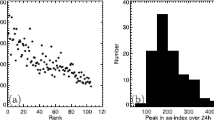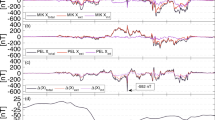Abstract—
In situ data on geomagnetic and auroral activity obtained in recent years has contributed to a greater understanding of solar–terrestrial processes. However, because space exploration began only in the middle of the 20th century, in situ data are insufficient to analyze geomagnetic variations and solar-activity variations on a time scale from decades to centuries. The Russian network of magnetic and meteorological observatories provides one of the longest data series. For example, the magnetograms from St. Petersburg (SPE), Pavlovsk (SLU), and Voeikovo (LNN) stations provide long series of continuous records of variations of declination (D) and horizontal (H) and vertical (Z) components of the geomagnetic field. The aim of this paper is to make this data publicly available. For this purpose, a specialized database has been developed for the study of various aspects of solar–terrestrial relationships, including heliobiomagnetology. The database contains (1) digital images of analog magnetograms from SPE (1869–1877) and SLU (1878–1921, images for 1921–1941 are still being scanned), (2) hourly values of declination D and horizontal H and vertical Z components of the geomagnetic field obtained at SPE and SLU stations for 1869–1914, (3) data on geomagnetic storms from the SLU station for 1878–1941 and from the LNN station for 1947–1954, and (4) data on aurora borealis observed at 141 stations of the Russian Meteorological Network for 1837–1909. The database is designed to provide online access to the Russian collection of historical data on geomagnetic and auroral activity. On this basis, it is possible to carry out research on various aspects of space weather and climate and use it, among other things, to solve problems of heliomagnetobiology. Users are provided with easy access to individual magnetograms at different zoom levels. Online access will allow a wide range of researchers to use these databases to solve problems related to historical space weather data.


Similar content being viewed by others
REFERENCES
Afanas’eva, V.I. and Bychkova, A.K., Svodnyi katalog magnitnykh bur' za 1949–1958 gody (Master Catalog of Magnetic Storms in 1949–1958), Moscow: IZMIRAN, 1979, pp. 7–93.
Annuaire magnétique et météorologique du corps des ingénieurs des mines de Russie. Annee 1841–1846, Kupffer, A.T., Ed., St.-Petersburg: l’Imprimerie de A. Jacobson, 1843–1849.
Ben’kova, N.P. and Kalinin, Yu.D., Catalog of magnetic storms of the Slutsk magnetic observatory, in Kosmicheskie dannye: Dekadnyi obzor (Space Data: Decadal Overview), Leningrad–Moscow: Gidrometeoizdat, 1941, vol. 125, p. 8; vol. 126, p. 5; vol. 127, p. 5.
Breus, T.K. and Rapoport, S.I., Magnitnye buri: Mediko-biologicheskie i geofizicheskie aspekty (Magnetic Storms: Medico–Biological and Geophysical Aspects), Moscow, 2004.
Breus, T.K., Komarov, F.I., and Rapoport, S.I., Medical effects of magnetic storms, Klin. Med., 2005a, no. 3, pp. 4–12.
Breus, T.K., Kleimenova, N.G., Kozyreva, O.V., and Rapoport, S.I., Possible biotropic influence of geomagnetic pulsations Pc1 (0.2–5.0) on the cardiovascular system, in Materialy 3-i Mezhdunar. konf. “Bolezni tsivilizatsii v aspekte ucheniya V.I. Vernadskogo” (Proceedings of the 3rd International Conference “Civilization Diseases in Terms of V.I.Vernadsky’s Theory”), Moscow: RUDN, 2005, p. 50.
Cherry, R., Schumann resonances—a plausible biophysical mechanism for the human health effects of solar/geomagnetic activity, Nat. Hazards, 2002, vol. 26, pp. 279–331.
Chibrikin, V.M., Samovichev, E.G., and Kashinskaia, I.V., Dynamics of social processes and geomagnetic activity. 1. Periodic components of variations in the number of recorded crimes in Moscow, Biofizika, 1995, vol. 40, pp. 1050–1053.
Chizhevskii, A.L., Zemnoe ekho solnechnykh bur' (The Terrestrial Echo of Solar Storms), Korzhuev, P.A, Ed., Moscow: Mysl’, 1976.
Curto, J.J., Araki, T., and Alberca, L.F., Evolution of the concept of sudden storm commencements and their operative identification, Earth Planets Space, 2007, vol. 59, pp. 1–12.
Feigin, V.L., Parmar, P.G., Barker-Collo, S., Bennett, D.A., Anderson, C.S., Thrift, A.G., Stegmayr, B., Rothwell, P.M., Giroud, M., Bejot, Ya., Carvil, P., Krishnamurthi, R., and Kasabov, N., Geomagnetic storms can trigger stroke: Evidence from 6 large population-based studies in Europe and Australasia, Stroke, 2014, vol. 45, no. 6, pp. 1639–1651.
Friedman, H., Becket, R.O., and Bachman, C.H., Geomagnetic parameters and psychiatric hospital admissions, Nature, 1953, vol. 200, pp. 626–628.
Goldberg, R.B. and Creasey, W.A., A review of cancer induction by extremely low frequency electromagnetic fields: Is there a plausible mechanism?, Med. Hypotheses, 1991, vol. 35, no. 3, pp. 265–274.
Handbook of Biological Effects of Electromagnetic Fields, Barnes, F.S. and Geenebaum, B., Eds., CRC Press, 2006.
Kleimenova, N.G., Pulsations in the geomagnetic field as an important biotropic factor of space weather, in Vliyanie kosmicheskoi pogody na cheloveka v kosmose i na Zemle: Tr. Mezhdunar. konf., g. Moskva, 4-8 iyunya 2012 g. (Space Weather Impact on Men in the Space and on the Earth: Proceedings of International Conference, Moscow, June 4–8, 2012), Grigor’ev, A.I. and Zelenii, L.M., Ed., Moscow: IKI RAN, 2013, vol. 1, pp. 163–183.
Kleimenova, N.G., Kozyreva, O.V., Breus, T.K., and Rapoport, S.I., Seasonal variations in myocardial infarctions and the possible biotropic influence of short-period geomagnetic pulsations on the human cardiovascular system, Biophysics, 2007, vol. 52, no. 6, pp. 625–631.
Komarov, F.I., Breus, T.K., Rapoport, S.I., Musin, M.M., and Naborov, I.V., Geliogeofizicheskie faktory i ikh vozdeistvie na tsiklicheskie protsessy v biosfere (Geophysical Factors and Their Influence on Cyclic Processes in the Biosphere), Moscow, 1989.
Kupfer, A.Ya., Nastavlenie k proizvodstvu magnitnykh i meteorologicheskikh nablyudenii, sostavlennoe direktorom Glavnoi fizicheskoi observatorii dlya magnitnykh observatorii Gornogo vedomstva: Pribavlenie k Svodu nablyudenii za 1852 g. (Manual for Magnetic and Meteorological Observations, Compiled by the Director of the Main Physical Observatory for Magnetic Observatories of the Office of Mining: Appendix to the Corpus of Observations for 1852), St. Petersburg, Korpus gorn. inzhenerov, 1855, pp. 35–53.
Kupfer, A.Ya., Rukovodstvo k proizvodstvu meteorologicheskikh nablyudenii, sostavlennoe A.Ya. Kupferom, direktorom Glavnoi fizicheskoi observatorii (Manual for Meteorological Observations, Compiled by A.Ya. Kupfer, the Director of the Main Physical Observatory), St. Petersburg: Tip. A. Yakobsona, 1857.
Letopisi Glavnoi fizicheskoi observatorii za 1870 g. (Annals of the Main Physical Observatory for 1870), St. Petersburg: Tip. Imperat. Akad. nauk, 1872.
Letopisi Glavnoi fizicheskoi observatorii. Toma za 1849-1852 gg. (Annals of the Main Physical Observatory for 1849–1852), Kupfer, A., Ed., St. Petersburg, Izd. A. Yakobsona, 1852–1855.
Lindsay, G.M., Luhmann, J.G., Russell, C.T., and Gaziz, P.R., On the sources of interplanetary shocks at 0.72 AU, J. Geophys. Res., 1994, vol. 99, pp. 11–17.
Lockwood, M., Nevanlinna, H., Vokhmyanin, M., Ponyavin, D., Sokolov, S., Barnard, L., Owens, M.J., Harrison, R.G., Rouillard, A.P., and Scott, C.J., Reconstruction of geomagnetic activity and near-Earth interplanetary conditions over the past 167 yr. Part 3: improved representation of solar cycle 11, Ann. Geophys., 2014, no. 32, pp. 367–381. doi 10.5194/angeo-32-367-2014
Mayaud, P., A hundred year series of geomagnetic data, 1868–1967: Indices aa, storm sudden commencements, IAGA Bull., No. 33, Paris: IUGG Publ. Office, 1973.
McNish, A.G., Sudden commencements at Watheroo, C. R. Assemblée de Lisbonne 1933, IATME Bull., 1934, no. 9, pp. 234–238.
Moos, N.A.F., Magnetic Observations Made at the Government Observatory for the Period 1846 to 1905. Part 2: The Phenomenon and Its Discussions, Bombay: Government Central Press by order of His Majesty’s Government, 1910, pp. 452–453, 457–459.
Newton, H.W., “Sudden commencements” in the Greenwich magnetic records (1879–1944) and related sunspot data, Mon. Not. R. Astron. Soc., 1948, vol. 5, pp. 159–185.
Ptitsyna, N.G., Villoresi, G., Dorman, L.I., Iucci, N., and Tyasto, M.I., Natural and man-made low-frequency magnetic fields as a potential health hazard, Phys.-Usp., 1998, vol. 41, no. 7, pp. 687–709.
Ptitsyna, N.G., Villoresi, G., Kopytenko, Yu.A., and Tyasto, M.I., Magnitnye polya na elektrotransporte i ekologiya cheloveka (Magnetic Fields in Electric Transport and Human Ecology), St. Petersburg: Nestor-Istoriya, 2010.
Ptitsyna, N.G., Tyasto, M.I., and Khrapov, B.A., Great geomagnetic storms in 1841–1870 according to the data from the network of Russian geomagnetic observatories, Geomagn. Aeron. (Engl. Transl.), 2012, vol. 52, no. 5, pp. 613–623.
Ptitsyna, N.G., Kopytenko, Y.A., Villoresi, G., Pfluger, D.H., Ismaguilov, V.S., Iucci, N., Kopytenko, E.A., Zaitzev, D.B., Voronov, P.M., and Tyasto, M.I., Waveform magnetic field survey in Russian DC- and Swiss AC-powered trains: A basis for biologically relevant exposure assessment, Bioelectromagnetics, 2003, vol. 24, pp. 546–556.
Ptitsyna, N.G., Tyasto, M.I., and Khrapov, B.A., 22-year cycle in the frequency of aurora occurrence in XIX century: Latitudinal Effects, Geomagn. Aeron. (Engl. Transl.), 2017, vol. 57, no. 2, pp. 190–198.
Randall, W. and Randall, S., The solar wind and hallucinations: A possible relation due to magnetic disturbances, Bioelectromagnetics, 1991, vol. 12, no. 1, pp. 67–70.
Rapoport, S.I., Breus, T.K., Kleimenova, N.G., Kozyreva, O.V., and Malinovskaya, N.K., Geomagnetic pulsations and myocardial infarction, Ter. Arkh., 2006, no. 4, pp. 56–60.
Roederer, J.G., Are magnetic storms hazardous to your health?, EOS, Trans. Am. Geophys. Union, 1995, vol. 76, pp. 441–456.
Sadafi, H.A., Mehboodi, Zh., and Sardar, D., A review of the mechanisms of interaction between the extremely low frequency electromagnetic fields and human biology, in Symposium on Progress in Electromagnetics Research, Cambridge, USA, 2006.
Sokolov, S.N. and Soldatov, V.A., Geomagnetic observations at Pavlovsk observatory in 1878–1914, in Proc. of the 10th Int. Conf. “Problems of Geocosmos”, Oct. 6–10, 2014, St. Petersburg, 2014, pp. 407–409.
Spravochnik po peremennomu magnitnomu polyu SSSR (Handbook on Alternating Magnetic Field of the USSR), Afanas’eva, V.I., Ed., Leningrad: Gidrometeoizdat, 1954, pp. 212–266.
Stewart, B., An Account of the Construction of the Self-Recording Magnetographs at Present in Operation at the Kew Observatory of the British Association, Report of the British Association for the Advancement of Science for 1859, London: Taylor and Francis, 1860.
Sunspot and Geomagnetic-Storm Data Derived from Greenwich Observations 1874–1954, London: Her Majesty’s Stationary Office, 1955, App. 1, pp. 102–103.
Svod nablyudenii, proizvedennykh v Glavnoi fizicheskoi i podchinennykh ei observatoriyakh pod rukovodstvom akademika A. Kupfera. Toma za 1848, 1853–1862 gg. (Corpus of Observations Made at the Main Physical Observatory and Its Subordinate Entities Under the Supervision of Academician A. Kupfer. Volumes for 1848, 1853–1862), St. Petersburg: Izd-vo A. Yakobsona, 1855.
Temur’yants, N.A., Vladimirskii, B.M., and Tishkin, O.G., Sverkhnizkochastotnye elektromagnitnye signaly v biologicheskom mire (ELF Electromagnetic Signals in the Biological World), Kiev: Naukova dumka, 1992.
Tyasto, M.I., Ptitsyna, N.G., Veselovsky, I.S., and Yakovchuk, O.S., Extremely strong geomagnetic storm of September 2–3, 1859, according to the archived data of observations at the Russian network, Geomagn. Aeron. (Engl. Transl.), 2009, vol. 49, no. 2, pp. 153–162.
UK Data. http://www.bgs.ac.uk/data/Magnetograms/ home.html. Accessed Sep. 1, 2016.
Valberg, P.A., Designing EMF experiments: What is required to characterize “exposure?”, Bioelectromagnetics, 1995, vol. 16, pp. 396–401.
Vil’d, G.I., Instruktsiya dlya meteorologicheskikh stantsii (Guideline for Meteorological Stations), St. Petersburg: Imperat. Akad. nauk, 1869.
Villoresi, G., Dorman, L.I., Ptitsyna, N.G., Iucci, N., and Tyasto, M.I., Forbush decreases as indicators of health-hazardous geomagnetic storms, in Proc. of the 24th International Cosmic Ray Conference, Rome, 1995.
Vincze, G., Szasz, A., and Liboff, A.R., New theoretical treatment of ion resonance phenomena, Bioelectromagnetics, 2008, vol. 29, pp. 380–386.
Vladimirskii, B.M., Grand minima of solar activity and sociodynamics of the culture, Geofiz. Protsessy Biosfera, 2011, vol. 10, no. 4, pp. 30–44.
Vladimirskii, B.M., Grand minima of solar activity and sociocultural dynamics, Geofiz. Protsessy Biosfera, 2012, vol. 11, no. 4, pp. 47–58.
Author information
Authors and Affiliations
Corresponding authors
Additional information
Translated by O. Pismenov
Rights and permissions
About this article
Cite this article
Ptitsyna, N.G., Sokolov, S.N., Soldatov, V.A. et al. Historical Database of Geomagnetic and Auroral Activity for the Study of Solar–Terrestrial Relationships. Izv. Atmos. Ocean. Phys. 54, 730–737 (2018). https://doi.org/10.1134/S0001433818070095
Published:
Issue Date:
DOI: https://doi.org/10.1134/S0001433818070095




